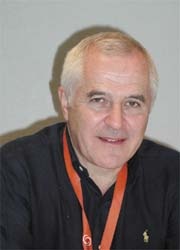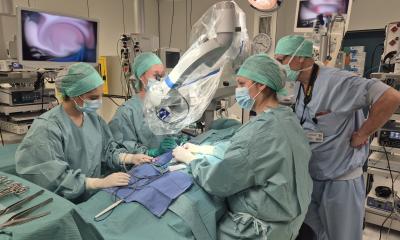Steroid sparing
A quiet revolution in transplant surgery
According to leading transplant specialists, within five years almost all renal transplants will be steroid free.

This may not sound a staggering innovation, but the implications are profound, according to Dr David Taube, Renal and Transplant Unit, St Mary’s Hospital, London.
Since the 1960’s steroids such as prednisone have been an integral part of post-transplant anti-rejection regimens. But steroids have numerous unpleasant side effects, including: nausea, vomiting, mood swings, thin skin, easy bruising, slow wound healing, bone and muscle problems, facial shape change, cataracts, and insomnia - to name a few. Steroids also have significant adverse effects on cardiovascular risk factors such as hypertension, hyperglycaemia, hyperlipidemia, and post-transplant diabetes mellitus.
‘For these reasons, we have been trying to withdraw steroids for many years. The first serious attempts started in the late 1990s with the availability of new immunosuppressive regimens such as tacrolimus, mycophenolate mofetil (MMF) and induction agents,’ Dr Taube explained.
Early results had suggested that risk of acute rejection and deterioration in graft function might result if corticosteroids were removed from the immunosuppressive cocktail. ‘More recently, studies have shown that steroids can be withdrawn from a tacrolimus-based regimen, or even avoided,’ he added.
Dr Taube recently completed a five-year audit of steroid withdrawal in more than 150 renal transplant recipients at St Mary’s Hospital, London. The results, he said, were reassuring. ‘Early and late steroid withdrawal in patients receiving tacrolimus-based immunosuppression resulted in excellent patients and graft survival, with a low incidence of post-transplant diabetes mellitus.’
Across Europe, something like one in ten renal transplants are currently ‘steroid free’. This proportion will increase rapidly as more centres become aware of the advantages of steroid sparing, he pointed out - but added that, for this to happen, surgeons and purchasers must appreciate the benefits, and be reassured their budgets will not suffer.
Faced with reluctance from some healthcare purchasers to embrace this new approach due to the increased cost of steroid-free immunosuppressive regimens, he pointed out that the total annual costs of steroid free immunosuppressive regimens are less than one year of the Erythropoietin therapy given to dialysis patients pre-transplant to avoid anaemia.
‘There is no doubt that in the UK, and in some other parts of Europe, we are dragging our feet about adopting this new technology. But you only have to ask most patients with renal failure whether they want steroids, and the answer is a resounding ‘no’ - they will do anything to get off steroids. I really think it is time we put a stop to steroids, and in five years I am sure we will have done.’
Dr Julio Pascual, Head of the Kidney Transplantation Programme, Ramon y Cajal Hospital, Madrid, Spain, agreed. Dr Pascual has been evaluating three steroid avoidance protocols: Complete steroid avoidance, steroid minimisation (give steroids for a few days and then withdraw), and steroid withdrawal after several months of treatment. His conclusion, presented at ESOT, was that modern tacrolimus-based regimens make it possible to minimise metabolic complications by eliminating corticosteroids without adversely impacting acute rejection rates or graft loss.
‘In low to medium immunological risk patients steroid-sparing strategies are advantageous in terms of reducing cardiovascular risk factors as well as improving bone mass loss. When receiving ciclosporin or tacrolimus + MMF, steroid withdrawal after the first months is associated with an increased incidence of mild acute rejection, but is effective and well-tolerated after 1-3 years of follow-up. Steroid avoidance or minimisation after anti-IL2 antibody induction and treatment with tacrolimus/MMF is an efficacious and safe option, at least during the first post-transplant year,’ he said.
An additional reason for avoiding steroids is the increasing age of the many transplant recipients. ‘In some areas of Spain, France, Italy and England, the percentage of renal allograft recipients who are over 60 years old, is growing exponentially, leaving us with a tremendous number of high risk patients in terms of cardiovascular morbidity and mortality - problems that are clearly exacerbated by steroid treatment,’ said Dr Pascual. ‘A final reason why we should embrace steroid-free regimens is because we are short of donor organs, and one of the most important causes of graft loss is the death of the recipient with a functioning graft. These deaths are mostly due to cardiovascular disease, so we must improve the cardiovascular risk profile of immunosuppressive regimens to save the patient and save the graft.’
‘Ten years ago steroid sparing was more a wish than a reality, but today there is good evidence supporting a steroid sparing strategy - the trouble is that for many transplant surgeon, steroids are a life-long companion. They know them, and know how to use them. They think they are non toxic (for the patient) despite clear evidence to the contrary,’ Dr Pascual pointed out. ‘They need to appreciate how much immunosuppressive non-compliance is driven by steroid-avoidance. Many young adults do not know which of their pills is giving them a hairy face, making them fat, and thinning their skin, so they stop all treatment. The result - the kidney is lost – an avoidable tragedy. Thank goodness things are starting to change.’
30.08.2006







